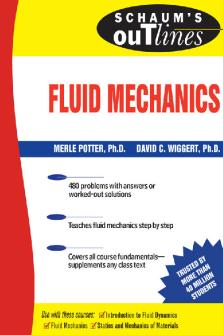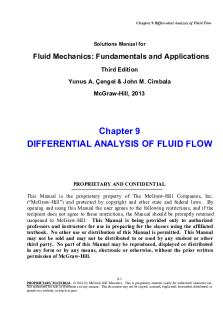Fluid Mechanics And Applications Chapter 5 Immersed BODY FLOW( Review) PDF

| Title | Fluid Mechanics And Applications Chapter 5 Immersed BODY FLOW( Review) |
|---|---|
| Course | Fluid Mechanics And Applications |
| Institution | University of Manitoba |
| Pages | 4 |
| File Size | 73 KB |
| File Type | |
| Total Downloads | 90 |
| Total Views | 149 |
Summary
Immersed Body Flow...
Description
2015-04-22
Chapter 5 IMMERSED BODY FLOW
When a viscous fluid passes a solid body the body experiences a net force ,F which can
be decomposed into 2 components which are 1) Drag Force ----It is parallel to the flow direction
2) Lift Force ---- It is perpendicular to the flow direction
A = Wetted Area --- Total surface area in contact with fluid
Ap = Plan form Area --- Maximum projected area of an object such as the wing
There are two types of Drag force which are 1) Friction Drag (Viscous Drag)--- Due to the wall friction shear stress exerted on the
surface of a solid body 2) Pressure Drag ( Form Drag)--- Due to the difference in the pressure on the front and the rear surfaces of a solid body For an inviscid body the total drag force exerted on a solid body is solely contributed by the pressure drag For a viscous flow the total drag force is a combination of both the friction and pressure drags
Laminar to turbulent Transition BL over a finite flat plate Viscous drag is significant when ReL is low At a given ReL the value of CD is less for laminar BL which implies that for a given
length of plate , the drag coefficient is less, when laminar flow is maintained over the longest possible distance . At range ReL( 1000) because the size of the wake is fixed by the geometry of the object .
Combined Friction and pressure Drag For a viscous laminar BL flow the BL separation occurs around 82 degrees For a turbulent BL flow the BL separation occurs around 120 degrees For a Turbulent
case the low pressure wake region is much reduced. Therefore the pressure difference between the front and the rear of a sphere is greatly reduced . Smooth Ball
Rough Ball
Drag force is not reduced . Wake
Dimples on a rough ball triggers
is thick
the onset of turbulence . Turbulent BL delays the BL separation and makes the low pressure wake region much narrower resulting in a much reduced pressure drag . With reduced drag force , a golf ball can fly over a much longer distance that a smooth ball
Characteristics Area in Drag Coefficient Characteristics assumes one of the following types : 1) Wetted Area --- Total area that is in contact with fluid 2) Frontal Area --- Projected area as seen by the flow 3) Plan form Area ----Maximum projected area as seen from above SREAMLINING The extent of wake (separated flow region) behind an object can be reduced or
eliminated using streamlining and this can also reduces pressure drag.
2015-04-22
2015-04-22 ...
Similar Free PDFs

Fluid Mechanics - External Flow
- 7 Pages

Chapter 14 Body mechanics
- 2 Pages

Fluid Mechanics and Hydraulics
- 5 Pages

FLUID MECHANICS AND HYDRAULICS
- 159 Pages

Fluid Mechanics
- 260 Pages

Fluid Mechanics
- 796 Pages

Fluid Mechanics
- 8 Pages

fluid mechanics
- 8 Pages
Popular Institutions
- Tinajero National High School - Annex
- Politeknik Caltex Riau
- Yokohama City University
- SGT University
- University of Al-Qadisiyah
- Divine Word College of Vigan
- Techniek College Rotterdam
- Universidade de Santiago
- Universiti Teknologi MARA Cawangan Johor Kampus Pasir Gudang
- Poltekkes Kemenkes Yogyakarta
- Baguio City National High School
- Colegio san marcos
- preparatoria uno
- Centro de Bachillerato Tecnológico Industrial y de Servicios No. 107
- Dalian Maritime University
- Quang Trung Secondary School
- Colegio Tecnológico en Informática
- Corporación Regional de Educación Superior
- Grupo CEDVA
- Dar Al Uloom University
- Centro de Estudios Preuniversitarios de la Universidad Nacional de Ingeniería
- 上智大学
- Aakash International School, Nuna Majara
- San Felipe Neri Catholic School
- Kang Chiao International School - New Taipei City
- Misamis Occidental National High School
- Institución Educativa Escuela Normal Juan Ladrilleros
- Kolehiyo ng Pantukan
- Batanes State College
- Instituto Continental
- Sekolah Menengah Kejuruan Kesehatan Kaltara (Tarakan)
- Colegio de La Inmaculada Concepcion - Cebu







